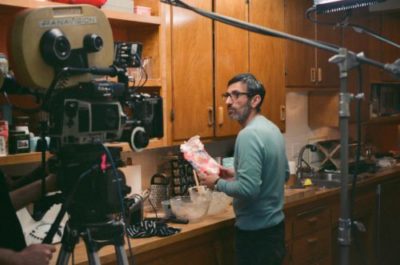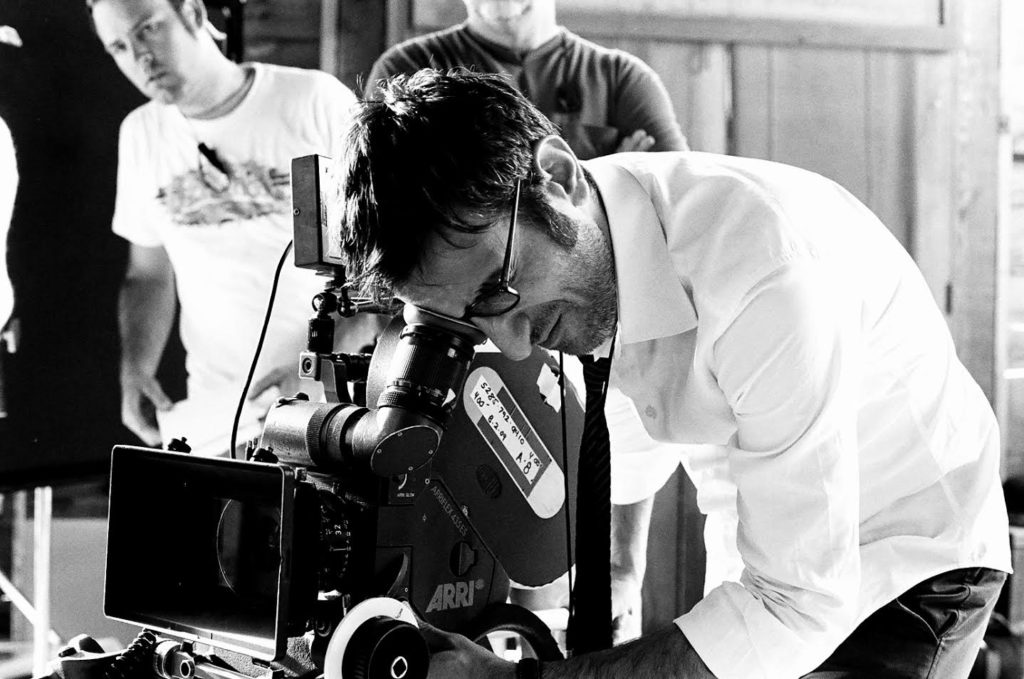2016 AIFF interviews with the filmmakers
Director Albert Kodagolian put himself to the test, wearing multiple hats—co-writer, director, cinematographer, actor—while employing real-time storytelling and allowing pure artistic intent to blossom into this must-see, Somewhere Beautiful. In this film, Kodagolian’s unconventional style of filmmaking (partially-scripted with the creative freedom to seize the moment) stimulates the strengths and weaknesses of his emotional tug of wars taking place in two different worlds, Patagonia and Hollywood.
Kodagolian’s Somewhere Beautiful has received three 2016 AIFF nominations for Best Feature Film, Best Director, and Best Screenplay. On November 5, this U.S. Premiere and AIFF Centerpiece film will be screened at 9:00pm at the Egyptian Theatre, followed by a celebratory reception.
Further, on November 6 at the Awards Ceremony, Albert Kodagolian will be honored with the 2016 AIFF Breakthrough Artist Award. Kodagolian, an Armenian born in Iran, USC School of Cinematic Arts graduate, graciously answered questions as a part of a series of interviews with 2016 AIFF category nominees.
Why did you choose to make your film?
The impetus and the initial force that propelled me to make this film was a direct reaction to the traditional methods of film making, where everything is obsessively discussed and overanalyzed. Instead I wanted to experiment and see if I could put together a small cast and crew, like a jazz ensemble, and make a film in real time, without storyboards, without a full script, and still manage to produce on the highest quality of 16mm and 35mm film. Looking back, I now realize that in my heart of hearts I wanted to create like an artist, with a pure artistic intent, to meditate and to express from a deep connection with nature and meaning.
Name a moment during shooting that made you proud.
On this notion of real-time creation, one morning while we were on our way to a location, I noticed this amazing dust storm. A forceful wind was sweeping across the desert. So I stopped the three cars in our convoy. The raw nature, its power and beauty, it was incredible and I decided I was going to shoot a scene right there and then. Within minutes I came up with a single line that began the scene which was “what’s wrong.” With the camera set on a tripod in one position, I filmed five or six different shots changing the size of the frame with a zoom lens. We shot the entire scene in 20 minutes, and to this day it is one of the strongest and most mysterious scenes I have ever directed.
Was there an “Aha moment” while making your film?
The process of filming “Somewhere Beautiful” was truly unorthodox. We shot one half of the film in Patagonia two years prior to the other half in Los Angeles and whereas the first half experienced a slower, more delayed editing process, the second part was edited quite traditionally. The aha moment, the major breakthrough, came during the third and final re-edits in London when I realized that the storytelling became exponentially stronger the more dialogue we cut out. As a filmmaker I was communicating the most when the film was literally saying the least. And this is where the unique visual grammar and poetic nature of the film found it’s fullest expression.
Was there a bizarre moment that happened while making your film?
Since everything was shot on film, and developed weeks and weeks later due to the nature of it being a favor, it meant that I didn’t see any footage until a month or so after we had finished shooting. There was a scene in the beginning of the film where I’m in the back of a car going home. Ironically we had shot the dialogue between the driver and I in a sound stage, but when we saw the synced up scene all the words sounded like they had been recorded underwater. No one knew the cause of the distortion since it only occurred in that one scene. However, instead of fixing the audio problem, we decided to cut that dialogue. Again, dialogue out, and in a bizarre sense, it was coincidentally perfect, like some other person, or consciousness, was trying to remind us to “stay on the path of visual storytelling.”
What is your favorite scene?
One of my favorite scenes in the film is where the Mapuches are performing their yearly ritual of taming wild horses, which in essence became the climax of the film. Our location fixer in Patagonia brought it to my attention when we were scouting the bridge crossing. It was pure synchronicity. I had always envisioned a scene where the two men have the woman in between them, visually. I wanted the three actors shot in profile, in slow motion, rack focusing from character to character. And the serendipity! We ended up shooting the horses also in super slow motion, and then intercutting with the footage of our actors. It was a god-given visual gift that became the metaphor of the film: falling down, getting back up, wanting to control and learning to let go.
What is your favorite line?
“You know what settlers do when they find new land? …they burn their boats”
“So they can’t go back?”
“So they can’t go back… Go forward my friend”
This is from a scene in the L.A. side of the film. It’s set in a recording studio. I based this character on my friend Dave, and there was a wonderful coincidence. This scene was written by Jimmy Kelly, who wrote the scripted side of the film with me and it was originally intended for two actors. But right before we started to shoot, my friend Dave showed up. We then decided to have him play along with us. At the end of one of the master takes, after we had finished performing the written words, I mentioned Einstein’s quote about achievement being its own reward and this led to a riff about the boats. That sentence “Go forward my friend” is absolutely concise and succinctly expressive and once again it originated because of the open nature of our approach.
What does it mean to have your film selected as a category nominee by the Arpa International Film Festival?
It’s a huge honor to be recognized by Arpa International Film Festival, which belongs to the rich cinematic tradition of Los Angeles. In actuality, most of our film was shot in Silverlake and in Beachwood Canyon, so this festival, the amazing recognition and support we’re receiving—the opportunity to show “Somewhere Beautiful” at the Egyptian theatre on Hollywood Boulevard—what better way to return home, like a complete full circle.
____________________________________________________
2016 AIFF Best Screenplay Nominee
 Albert Kodagolian, Matthew Bedard, and Jimmy Kelly are co-writers of Somewhere Beautiful. Jimmy Kelly shares his perspective regarding the screenplay for this unconventionally shot film.
Albert Kodagolian, Matthew Bedard, and Jimmy Kelly are co-writers of Somewhere Beautiful. Jimmy Kelly shares his perspective regarding the screenplay for this unconventionally shot film.
What was the writing process like?
It was a unique experience, my first professionally. I was still very recently out of film school when I was connected with Albert, who had already shot everything in Patagonia he’d written with Matthew. When it came time to write the Los Angeles half of the film, Matthew didn’t have the availability to write—outside of some great punch ups he wound up doing—so I was brought in. When we first met, Albert laid out all these scenes he had jotted down on different colored note cards. He and I broke the story for that half of the film and he trusted me to go off and create a draft. It was all very fast and furious, especially the rewrites where a lot changed. Certain scenes had to be ready early to accommodate the schedule of Dominique Pinion, who was flying in from France to film his scenes and had to be back in France in time to do a play. We started writing in October and that led to a mad rush to film all of Dominique’s scenes around Christmas. I set up the scenes and Matthew mostly handled the dialogue, since Dominique was playing the editor of a fashion magazine and Matthew writes for and knows that world. So Albert shot those three big scenes with Dominique and we hadn’t even fully committed to how the story around those scenes will end—we just knew we had these three great scenes. But we got there, we got the final script where we wanted it to be. It was a unique writing experience to say the least, and while it’s one I wouldn’t want to repeat, it was a pretty fun experience that ultimately suited the experimental tone of the film quite well. If Albert had just decided to lock in the script early to avoid all these technical headaches, the final film would’ve suffered. That Albert trusted me to essentially fix the car as it was racing around the track meant a lot to me, and I’m very proud of the result.
How did the subject matter of the film impact you while writing the screenplay?
At first I thought my value would be in writing the nanny character, Matilda, because she’s the one character in the Los Angeles half of the film who’s my age. Coming up, I was always focused on these younger characters who were trying to figure out their lives, because I was (and still in many ways am) a young person trying to figure out my life. But having said all that, I ended up connecting most to Albert’s character, which was coming from a very real place for him. That story was very loosely based on a personal heartbreak from Albert’s life and the more I got to know Albert the person, the more I found myself emotionally invested in writing for Albert the character. I’ve never had my heart broken like that, so initially it was hard to find my way in, but then it all turned when I realized the emotional core of the film and Albert as a character ran deeper than the fallout of a relationship drama. It was Albert’s backstory, his life, everything he struggled through to get to Los Angeles in the first place and how, after all of that, he was able to build a career, a family and a life The idea of struggling to build all of that only for this person you love, this person who is so central to the life you’ve built, to leave, and you feel in many ways responsible for that loss, I understood even as an outsider to Albert’s story how devastating and terrifying it could be to feel like you have to start over again. Albert told me the story of how he came to America shortly after we first met. It wasn’t until deep into the writing process that I realized that was the story audiences needed to hear.
How long did it take you to complete the script?
The Los Angeles half of the script took about three to four months to fully figure out with a lot of interesting bumps along the way, as previously mentioned. Since that script I’ve been able to consistently write twice as much in about half the time, but this was not only a unique writing experience, it was my first time being paid to write something. It was my trial by fire and reflecting on it now and how my career has progressed since, I’m so grateful to have had the challenge and the opportunity. I was working with someone who was never going to give up on making this film, and it was also Albert’s directorial debut. So we were bonded in sharing the experience from that perspective, but making it the best it could be was worth every step.
Somewhere Beautiful (2014) | 75 min. | Drama | USA, Argentina
Be sure to check out the trailer and buy tickets, they’re selling fast!
 Written by Sharon Swainson
Written by Sharon Swainson
Communications & Development Director
2016 Arpa International Film Festival

